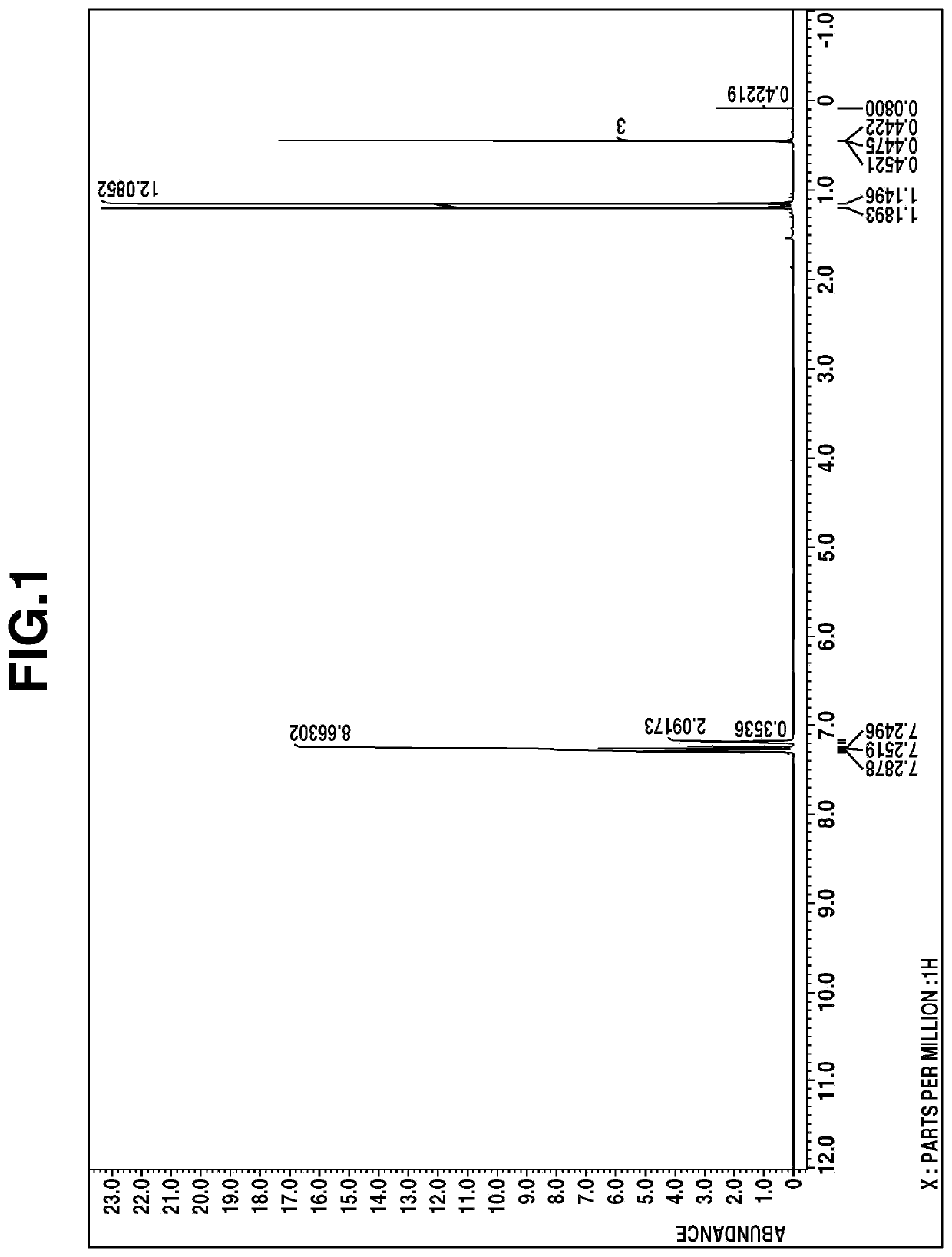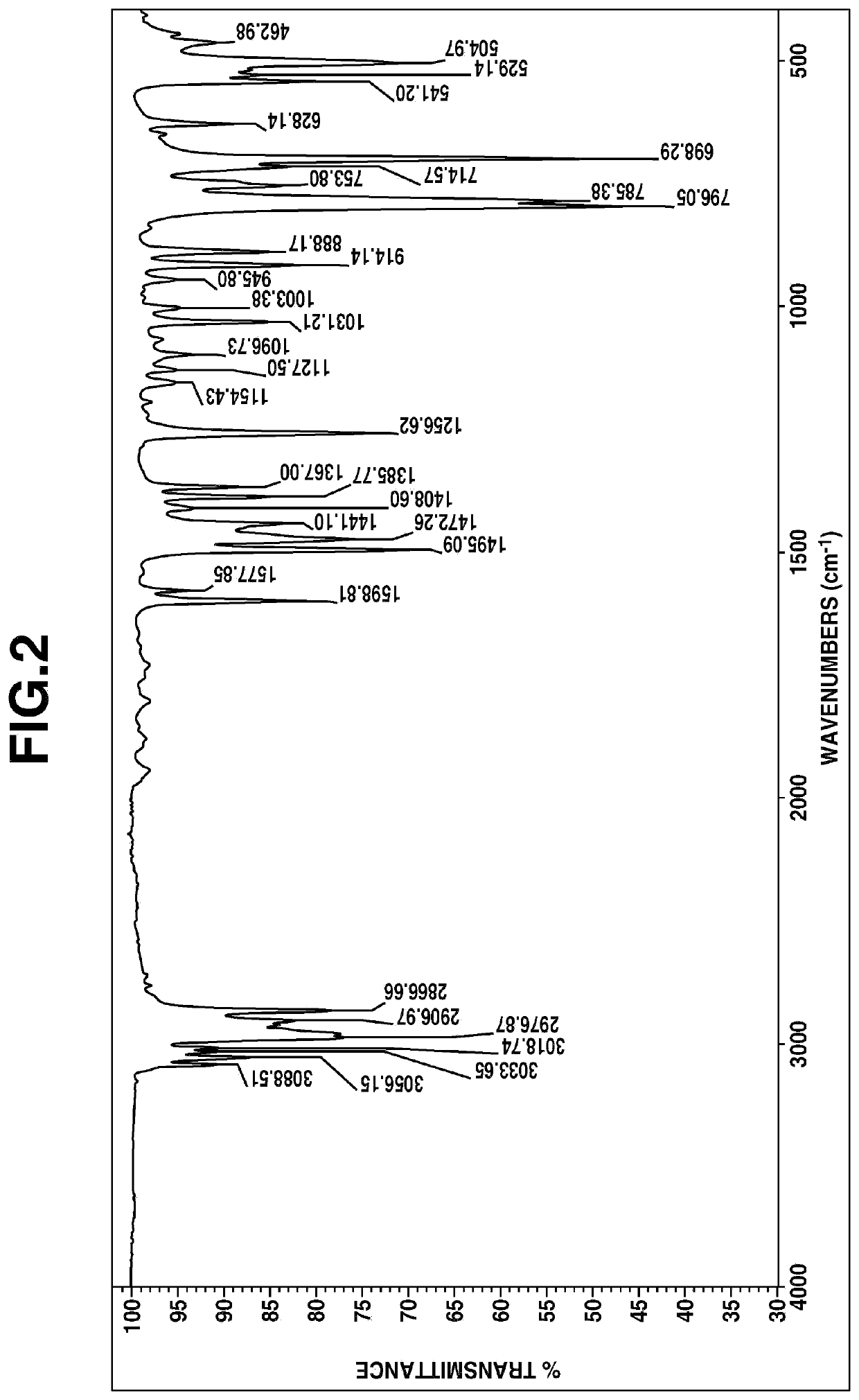Organosilane compounds having bulky substituent and preparation thereof
- Summary
- Abstract
- Description
- Claims
- Application Information
AI Technical Summary
Benefits of technology
Problems solved by technology
Method used
Image
Examples
example 1
Synthesis of bis(1-methyl-1-phenylethyl)methylchlorosilane
[0043]A four-neck flask equipped with a stirrer, reflux condenser, dropping funnel and thermometer was purged with nitrogen. While nitrogen gas was fed to the open top of the reflux condenser to block the entry of ambient air, the flask was charged with 1.4 g (5.00 mmol) of bis(1-methyl-1-phenylethyl)methylsilane, 2.3 g (25.00 mmol) of methallyl chloride, and 11.2 mg (0.05 mmol) of palladium acetate, which were stirred at 150° C. for 20 hours. The reaction solution was passed through a 0.5-μm membrane filter. The filtrate was concentrated at 50° C. / 5.0 kPa, yielding 1.4 g of a pale yellow liquid.
[0044]The liquid was analyzed by mass spectroscopy, 1H-NMR spectroscopy (deuterated chloroform), and IR spectroscopy. The results of mass spectroscopy are shown below.
[0045]m / z 316, 197, 155, 119, 93
The 1H-NMR spectral chart is shown in FIG. 1 and the IR spectral chart is shown in FIG. 2.
[0046]From these results, the resulting compoun...
example 2
Synthesis of bis(1-methyl-1-phenylethyl)methylsilyltriflate
[0047]A four-neck flask equipped with a stirrer, reflux condenser, dropping funnel and thermometer was purged with nitrogen. While nitrogen gas was fed to the open top of the reflux condenser to block the entry of ambient air, the flask was charged with 14.1 g (50.00 mmol) of bis(1-methyl-1-phenylethyl)methylsilane, which was stirred at 0° C. 7.4 g (49.00 mmol) of trifluoromethanesulfonic acid was added dropwise, after which the contents were stirred at room temperature for 2 hours. The reaction solution was distilled, collecting 11.3 g of a fraction of boiling point 178° C. / 0.4 kPa.
[0048]The fraction was analyzed by mass spectroscopy, 1H-NMR spectroscopy (deuterated chloroform), and IR spectroscopy. The results of mass spectroscopy are shown below.
[0049]m / z 311, 227, 181, 139, 119, 91
The 1H-NMR spectral chart is shown in FIG. 3 and the IR spectral chart is shown in FIG. 4.
[0050]From these results, the resulting compound was...
example 3
Synthesis of tert-butylmethyl(1-methyl-1-phenylethyl)chlorosilane
[0051]A four-neck flask equipped with a stirrer, reflux condenser, dropping funnel and thermometer was purged with nitrogen. While nitrogen gas was fed to the open top of the reflux condenser to block the entry of ambient air, the flask was charged with 1.1 g (5.00 mmol) of tert-butylmethyl(1-methyl-1-phenylethyl)silane, 2.3 g (25.00 mmol) of methallyl chloride, and 11.2 mg (0.05 mmol) of palladium acetate, which were stirred at 150° C. for 11 hours. The reaction solution was passed through a 0.5-μm membrane filter. The filtrate was concentrated at 50° C. / 5.0 kPa, yielding 1.2 g of a pale yellow liquid.
[0052]The liquid was analyzed by mass spectroscopy, 1H-NMR spectroscopy (deuterated chloroform), and IR spectroscopy. The results of mass spectroscopy are shown below.
[0053]m / z 254, 155, 135, 118, 93, 41
The 1H-NMR spectral chart is shown in FIG. 5 and the IR spectral chart is shown in FIG. 6.
[0054]From these results, the...
PUM
 Login to View More
Login to View More Abstract
Description
Claims
Application Information
 Login to View More
Login to View More - R&D
- Intellectual Property
- Life Sciences
- Materials
- Tech Scout
- Unparalleled Data Quality
- Higher Quality Content
- 60% Fewer Hallucinations
Browse by: Latest US Patents, China's latest patents, Technical Efficacy Thesaurus, Application Domain, Technology Topic, Popular Technical Reports.
© 2025 PatSnap. All rights reserved.Legal|Privacy policy|Modern Slavery Act Transparency Statement|Sitemap|About US| Contact US: help@patsnap.com



